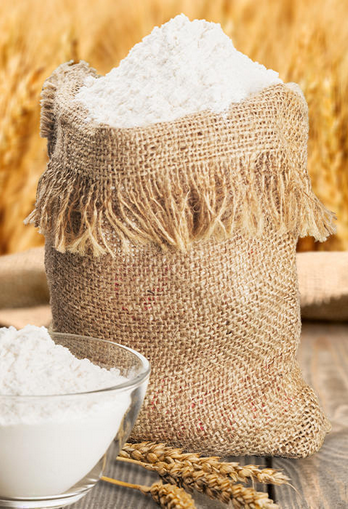 Wheat flour is a powder made from the grinding of wheat used for human consumption. Wheat varieties are called “soft” or “weak” if gluten content is low, and are called “hard” or “strong” if they have high gluten content. Hard flour, or bread flour, is high in gluten, with 12% to 14% gluten content, and its dough has elastic toughness that holds its shape well once baked. Soft flour is comparatively low in gluten and thus results in a loaf with a finer, crumbly texture. Soft flour is usually divided into cake flour, which is the lowest in gluten, and pastry flour, which has slightly more gluten than cake flour.
Wheat flour is a powder made from the grinding of wheat used for human consumption. Wheat varieties are called “soft” or “weak” if gluten content is low, and are called “hard” or “strong” if they have high gluten content. Hard flour, or bread flour, is high in gluten, with 12% to 14% gluten content, and its dough has elastic toughness that holds its shape well once baked. Soft flour is comparatively low in gluten and thus results in a loaf with a finer, crumbly texture. Soft flour is usually divided into cake flour, which is the lowest in gluten, and pastry flour, which has slightly more gluten than cake flour.
In terms of the parts of the grain (the grass fruit) used in flour—the endosperm or protein/starchy part, the germ or protein/fat/vitamin-rich part, and the bran or fiber part—there are three general types of flour. White flour is made from the endosperm only. Brown flour includes some of the grain’s germ and bran, while whole grain or wholemeal flour is made from the entire grain, including the bran, endosperm, and germ. Germ flour is made from the endosperm and germ, excluding the bran.
Milling
To produce refined (white) wheat flour, grain is usually tempered, i.e. moisture added to the grain, before milling, to optimize milling efficiency. This softens the starchy “endosperm” portion of the wheat kernel, which will be separated out in the milling process to produce what is known to consumers as white flour. The addition of moisture also stiffens the bran and ultimately reduces the energy input required to shatter the kernel, while at the same time avoiding the shattering of bran and germ particles to be separated out in this milling process by sieving or sifting.
The endosperm portion of the kernel makes up about 80% of the volume and is desirable because the products made from this white flour are often considered to have a milder flavor, smoother texture, and, in the case of bread, greater volume. The balance of the kernel is composed of the bran and the germ which tend to be coarser. With the invention of the roller milling system in the late 19th century, the bran and the germ were able to be removed, dramatically improving the appeal of baked products to the public.
The moistened grain is first passed through the series of break rollers, then sieved to separate out the fine particles that make up white flour. The balance are intermediate particles of endosperm (otherwise known as product middling or farina) and coarse particles of bran and germ. The middling then makes multiple passes through the reduction rolls, and is again sieved after each pass to maximize extraction of white flour from the endosperm, while removing coarser bran and germ particles.
To produce whole wheat flour, 100% of the bran and germ must be reintroduced to the white flour that the roller milling system was originally designed to separate it from. Therefore, these elements are first ground on another mill (usually a pin mill). These finer bran and germ fractions are then reintroduced to the endosperm (white flour) to produce whole wheat flour made of 100% of the kernel of wheat.






